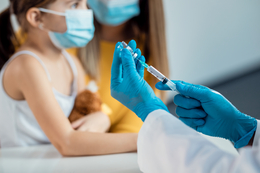
Based on the questions she’s received throughout the pandemic from concerned and curious parents, there are a few things Dr. Jeanne Craft thinks people need to know about the recently approved COVID-19 vaccine for children 5-11 years old, which received emergency-use authorization from the U.S. Food and Drug Administration (FDA) in late October.
“This vaccine has been rigorously tested,” says Craft. “We have experience with millions of older children who have gotten this vaccine, millions of adults who have gotten the vaccine, and the trials were done with the scientific rigor necessary for us to have confidence that this vaccine is safe and effective.”
Craft is the president of the American Association of Pediatricians’ New Jersey chapter, which champions the optimal health, safety and well-being of the state’s infants, children, adolescents and young adults. In both her role with the association and as a practicing physician, she has engaged in whatever conversations are necessary to assuage parental fears and dispel disinformation.
She explains that the approval comes after reviews by both the federal Centers for Disease Control and Prevention (CDC) and FDA advisory panels, and that the pediatric Pfizer vaccine is, like previously approved versions for those 12 and older, administered in two doses 21 days apart.
Craft echoes the sentiments expressed in a press release issued by New Jersey Department of Health Commissioner Judith Persichilli underscoring the commissioner’s support of the lower, child-sized dosage of the Pfizer vaccine, the approval of which was announced by the FDA Oct. 29.
“The Department of Health urges everyone ages 5 and older to get vaccinated against COVID-19 as soon as possible,” Persichilli wrote. “[It] is an important step forward in ensuring that as many people as possible get vaccinated against COVID-19. ... Clinical data examined by FDA has shown that the vaccine is safe and 90.7% effective in preventing COVID-19 in children ages 5 through 11.”
Less than a week after the newest COVID vaccine became available, Craft reports that 1% of New Jersey’s 760,000 (about 7,600) children within that age range received their first shot.
“We’re off to a great start,” she says. “There were a lot of parents just waiting for that authorization and they are getting their children in as quickly as possible.”
For area schools, especially those whose districts comprise some of South Jersey’s youngest students, the newest vaccine approval is an optimistic glimmer of light at the end of the tunnel.
“It means that in-person instruction is almost guaranteed to continue for the school year,” says Dr. George Rafferty, superintendent of the K-8 Mount Laurel School District. “If our 5-11-year- olds are vaccinated, they never have to quarantine if they come into close contact with another student who has COVID. They can stay in school as long as they don’t develop symptoms.”
With the district’s Harrington Middle School already benefiting from the approved vaccine for children 12 and older, Rafferty tentatively welcomes both the diminished reliance on substitute teachers and decrease in pupils’ absences, especially since so many students are still feeling the effects of remote education’s learning loss.
“With our 5-11-year-olds recently becoming eligible for vaccination, I’m really hopeful that will mitigate our quarantining when we have kids coming to school with [COVID] symptoms, which is disruptive for everyone,” he says. “Those kids have to stay home for 10 calendar days before they can come back to school.”
As “the majority of staff” is vaccinated (those who aren’t have been submitting weekly proof of negative COVID tests), plus a promising number of middle schoolers already receiving the vaccination, the Mount Laurel schools will host a vaccination clinic to help keep the numbers of protected students on the rise.
But Rafferty notes that while the district’s official policy is to abide by health professionals’ recommendations, its intent is to neither overstep when it comes to parents’ or guardians’ choices nor replace the advice of families’ trusted medical professionals.
“The schools’ position is to follow the health guidelines and mandates put out by the state of New Jersey and the Department of Health, so we would not mandate a vaccination if it were not mandated by the state,” he confirms.
And while Craft notes that many parents jumped at the chance to begin their young children’s two-step COVID vaccination process, others remain understandably torn, reluctant or unsure of how quickly they should proceed with vaccinating their children—or if they should at all.
“There are other parents who I think are going to be a little more hesitant,” she notes. “Sometimes it’s just a general concern. Sometimes it’s not really vaccine refusal, exactly: It’s a vaccine hesitancy or vaccine questioning. I think you have to understand where they’re coming from.”
A father in Marlton who wished to remain anonymous notes that, while he and his wife both received their full rounds of COVID shots, they’re not hurrying to vaccinate their young daughter who just recently became eligible for the 5-11 dose—though they remain mindful about the safety of immunocompromised loved ones.
“[We’re] not as much apprehensive as just not in a rush,” he says. “[Our daughter] has all her other vaccinations up to date, and it seems like COVID really impacts the older age groups with other significant comorbidities. The CDC and Mayo [Clinic] outline most kids only have mild cases if they are symptomatic at all. The big thing is my wife’s dad, who has asthma and heart issues and had cancer. We have to be very careful there, so we are continuing with masks and distancing as much as possible.”
Meg Hollingworth of Haddonfield says she and her husband already got their COVID boosters, and their 7- and 11-year-old daughters were vaccinated as soon as possible.
“We got my daughters’ first shots within a week of it becoming available for children 5 and up,” she says.
To Hollingworth, ensuring that her whole family was protected against COVID after nearly two years of uncertainty was a significant motivator.
“Throughout the pandemic, my motto was, ‘Focus on what I can control, the world’s going crazy’—I can only control my own household, and getting my family vaccinated is the best way to do that,” she says.
Craft notes that medical professionals should keep the conversation about vaccines going, as it’s up to them to responsibly educate and allay the fears of the concerned parents who seek their input and advice.
“I think the role of pediatricians and family practitioners who vaccinate and see children on a regular basis is going to be crucial,” Craft notes. “A lot of parents want to talk about this with people they trust and who understand the science of [the vaccine].”
She understands that, since the public rarely sees all the behind-the-scenes efforts that go into vaccine testing, the optics may make it seem like the shot for 5-11-year-olds has been rushed.
“This all seems to have happened incredibly fast but it has been good science,” Craft says. “It has been done with the same rigor that other vaccines and other medications have been developed with. People have been working on the mRNA viruses for a long time … so when this challenge came, a lot of that framework was already there, which a lot of people don’t realize.
“We’ve never seen this unprecedented type of information-sharing before: Laboratories in many, many countries—the United States was not the only one working on this—really helped drive the process,” she continues. “It still had to go through all the testing that the FDA and CDC require. Then the FDA team had to review the data rigorously. And then, once the FDA reviewed it and said, ‘The data is safe, this is effective,’ the CDC and the Advisory Committee on Immunization Practices looked at it. As soon as they said, ‘We have confidence that this is a safe and effective and worthwhile vaccine for children,’ they made the recommendation—and then we were off and running.”
With the Delta variant hitting the younger population harder than previous strains, she adds that it’s important to make sure physician-led conversations include information about both long-haul COVID’s lingering symptoms and the multisystem inflammatory syndrome in children (MIS-C) associated with the novel coronavirus, as the two are rare but “can be very concerning.”
“Children with [MIS-C], a lot of them wind up in the hospital, they wind up in ICUs, there have been a few deaths—not many, because the medicine is good and the ICU care is aggressive—but MIS-C is, perhaps, what looks the scariest on paper because it can happen quickly and involves the heart,” Craft explains. “My adolescent-medicine colleagues are also starting to see long COVID in adolescents: kids who are having trouble concentrating in school, kids who are moody, kids who are tired all the time. If we are really concerned about how well children can learn in school, we need to be worried about long COVID.”
Since Hollingworth jumped on the vaccines, her daughters received their full course of shots right before the holiday season kicked off, allowing her family to enjoy its biggest get-together since 2019 while her daughters’ lives gradually return to normal.
“We gathered as 12 fully vaccinated extended family members this Thanksgiving, which we haven’t been able to do in a very long time,” she says. “My daughters were so excited to get their vaccines because they associated it with freedom. My almost-12-year-old is thrilled to have sleepovers with her vaccinated friends again—at that age, that’s a really big deal.”
Even though the staggering majority of 5-11 year olds weren’t fully vaccinated by Thanksgiving, they could be by January’s return to school—just in time for the winter holidays and flu season.
“The younger kids who are getting the shots now are not going to be fully protected until the new year, perhaps—but they’ll be better protected,” Craft points out. “The good news is you can get your COVID and flu vaccines on the same day, so they’ll have maybe a sore arm for one day instead of coming back for the second shot and having two sore-arm days.”
Of course, the advice Craft has been offering all throughout the pandemic remains the same for as long as COVID is a pernicious reality.
“Until a larger percentage of the population is vaccinated, we still need to keep a layered approach: Wash your hands, wear a mask, stay home if you’re sick,” she says. “If you aren’t vaccinated and aren’t wearing a mask, don’t get too close to other people, both for your own safety and for the safety of the people you care about.”
Click here to subscribe to the free digital editions of South Jersey Magazine
To read the digital edition of South Jersey Magazine, click here.
Published and copyrighted in South Jersey Magazine, Volume 18, Issue 8 (November 2021)
For more info on South Jersey Magazine, click here.
To subscribe to South Jersey Magazine, click here.
To advertise in South Jersey Magazine, click here.












